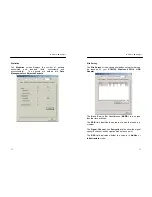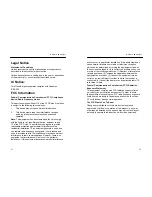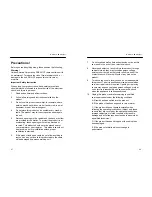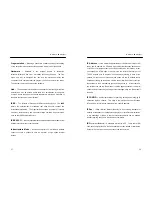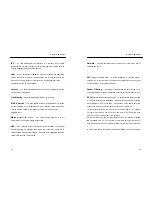
Wireless USB Adapter
59
RJ-45
–
A connector similar to a telephone connector that holds up to eight
wires, used for connecting Ethernet devices.
Router
–
Protocol-dependent device that connects sub networks together.
Routers are useful in breaking down a very large network into smaller sub
networks; they introduce longer delays and typically have much lower
throughput rates than bridges.
Server
–
Any computer whose function in a network is to provide user
access to files, printing, communications, and other services.
Signal Strength
–
Determines the strength of the signal for each
wireless channel.
Software
–
Instructions for the computer. A series of instructions that
performs a particular task is called a “program.” The two major categories of
software are “system software” and “application software.” System software
is made up of control programs such as the operating system and database
management system (DBMS). Application software is any program that
processes data for the user.
A common misconception is that software is data. It is not, software tells the
hardware how to process the data.
SOHO
(Small
O
ffice/
H
ome
O
ffice) – Market segment of professionals who
work at home or in small offices.
Wireless USB Adapter
60
Static IP Address
–
A permanent IP address that is assigned to a node
in a TCP/IP network.
Static Routing
–
Forwarding data in a network via a fixed path.
Static routing cannot adjust to changing line conditions as can dynamic
routing.
Subnet Mask
–
The method used for splitting IP networks into a series of
subgroups, or subnets. The mask is a binary pattern that is matched up with
the IP address to form part of the host ID address field into a field for subnets.
Switch
–
1. A data switch connects computing devices to host computers,
allowing a large number of devices to share a limited number of ports.
2. A device for making, breaking, or changing the connections in an
electrical circuit.
TCP
(
T
ransmission
C
ontrol
P
rotocol) – A method (protocol) used along with
the Internet Protocol (IP) to send data in the form of message units between
computers over the Internet. While IP takes care of handling the actual
delivery of the data, TCP keeps track of the individual units of data
(called packets) that a message is divided into for efficient routing through
the
Internet.
TCP/IP
–
T
ransmission
C
ontrol
P
rotocol/
I
nternet
P
rotocol (TCP/IP) is the
basic communication language or protocol of the Internet. It can also be
used as a communication protocol in a private network (either an intranet or
an extranet). When you are set up with access to the Internet, your computer
uses the TCP/IP protocol.

